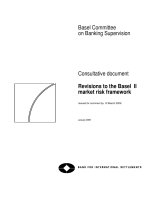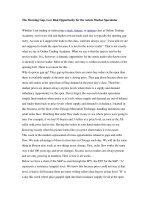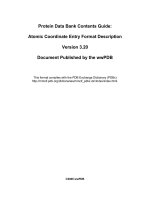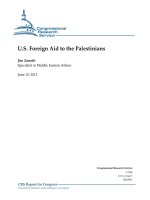Consultative document Revisions to the Basel II market risk framework
Bạn đang xem bản rút gọn của tài liệu. Xem và tải ngay bản đầy đủ của tài liệu tại đây (250.31 KB, 31 trang )
Basel Committee
on Banking Supervision
Consultative document
Revisions to the Basel II
market risk framework
Issued for comment by 13 March 2009
January 2009
Requests for copies of publications, or for additions/changes to the mailing list, should be sent to:
Bank for International Settlements
Press & Communications
CH-4002 Basel, Switzerland
E-mail:
Fax: +41 61 280 9100 and +41 61 280 8100
© Bank for International Settlements 2009. All rights reserved. Brief excerpts may be reproduced or translated
provided the source is stated.
ISBN print: 92-9131-774-8
ISBN web: 92-9197-774-8
Contents
I.
Background and objectives .............................................................................................1
II.
Implementation date........................................................................................................3
III.
Changes to the standardised measurement method for market risk...............................3
IV.
Changes to the internal models approach to market risk ................................................6
V.
Changes to the supervisory review process for market risk..........................................19
VI.
Changes to the disclosure requirements for market risk ...............................................20
VII.
Treatment for illiquid positions.......................................................................................21
Revisions to the Basel II market risk framework
i
Trading Book Group of the Basel Committee on Banking Supervision
Co-chairs:
Ms Norah Barger, Board of Governors of the Federal Reserve System, Washington, DC, and
Mr Thomas McGowan, Securities and Exchange Commission, Washington, DC
Belgium Mr Marc Peters Banking, Finance and Insurance
Commission, Brussels
Canada Mr Greg Caldwell
Mr Timothy Fong
Office of the Superintendent of Financial
Institutions Canada
France Mr Stéphane Boivin French Banking Commission, Paris
Germany Mr Karsten Stickelmann Deutsche Bundesbank, Frankfurt
Mr Frank Vossmann Federal Financial Supervisory Authority,
Bonn
Italy Mr Filippo Calabresi Bank of Italy, Rome
Japan Mr Masaki Bessho Bank of Japan, Tokyo
Mr Atsushi Kitano Financial Services Agency, Tokyo
Netherlands Mr Maarten Hendrikx Netherlands Bank, Amsterdam
South Africa Mr Rob Urry South African Reserve Bank, Pretoria
Spain Mr José Lopez del Olmo Bank of Spain, Madrid
Switzerland Ms Barbara Graf Swiss Financial Market Supervisory
Authority, Berne
United Kingdom Mr Colin Miles Bank of England, London
Mr Martin Etheridge Financial Services Authority, London
United States Mr Sean Campbell
Mr David Jones
Mr Chris Laursen
Board of Governors of the Federal Reserve
System, Washington, DC
Mr John Kambhu
Ms Emily Yang
Federal Reserve Bank of New York
Ms Gloria Ikosi
Mr Karl Reitz
Federal Deposit Insurance Corporation,
Washington, DC
Mr Ricky Rambharat
Mr Alexander Reisz
Mr Roger Tufts
Office of the Comptroller of the Currency,
Washington, DC
Mr Jonathan D Jones
Ms Christine Smith
Office of Thrift Supervision, Washington, DC
EU Mr Kai Gereon Spitzer European Commission, Brussels
Financial Stability
Institute
Mr Stefan Hohl Financial Stability Institute, Bank for
International Settlements, Basel
Secretariat Mr Martin Birn
Mr Karl Cordewener
Secretariat of the Basel Committee on
Banking Supervision, Bank for International
Settlements, Basel
Guidelines for computing capital for incremental risk in the trading book
iii
Revisions to the Basel II market risk framework
I. Background and objectives
1. The Basel Committee/IOSCO Agreement reached in July 2005
1
contained several
improvements to the capital regime for trading book positions. Among the revisions was a
new requirement for banks that model specific risk to measure and hold capital against
default risk that is incremental to any default risk captured in the bank’s value-at-risk model.
The incremental default risk charge was incorporated into the trading book capital regime in
response to the increasing amount of exposure in banks’ trading books to credit-risk related
and often illiquid products whose risk is not reflected in value-at-risk. At its meeting in March
2008, the Basel Committee on Banking Supervision (the Committee) decided to expand the
scope of the capital charge to capture not only defaults but a wider range of incremental
risks, to improve the internal value-at-risk models for market risk and to update the prudent
valuation guidance for positions accounted for at fair value.
2. Given the interest of both banks and securities firms in the
potential solutions to
these particular issues, the Committee has worked jointly with the International Organization
of Securities Commissions (IOSCO) to consult with industry representatives and other
supervisors on these matters. While this work was undertaken jointly by a working group
from the Committee and IOSCO, the resulting proposal represents an effort by the
Committee to find prudential treatments for certain exposures held by banks under the
Basel II Framework. Consequently, this text frequently refers to rules for banks, banking
groups, and other firms subject to prudential banking regulations. The Committee recognises
that, in some cases, national authorities may decide to apply these rules not just to banks
and banking groups, but also to investment firms, to groups of investment firms and to
combined groups of banks and investment firms that are subject to prudential banking or
securities firms’ regulation.
3. In June 2006, the Committee published a comprehensive version of the Basel II
Framework
2
which includes the June 2004 Basel II Framework, the elements of the 1988
Accord that were not revised during the Basel II process, the 1996 Amendment to the Capital
Accord to incorporate market risks, and the July 2005 paper on The application of Basel II to
trading activities and the treatment of double default effects. Unless stated otherwise,
paragraph numbers in this consultative document refer to paragraphs in the comprehensive
version of the Basel II Framework.
4. The Committee released consultative documents on the revisions to the Basel II
market risk framework and the guidelines for computing capital for incremental risk in the
trading book in July 2008. 15 comment letters have been provided by banks, industry
associations, supervisory authorities and other interested institutions. Those are available on
the Committee’s website. The Committee and IOSCO wish to thank representatives of the
industry for their fruitful comments. The Committee and IOSCO worked diligently, in close
cooperation with representatives of the industry, to reflect their comments in the present
paper and the Guidelines.
1
Basel Committee on Banking Supervision, The Application of Basel II to trading activities and the treatment of
double default effects, July 2005.
2
Basel Committee on Banking Supervision, Basel II: International convergence of capital measurement and
capital standards: a revised framework, comprehensive version, June 2006.
Revisions to the Basel II market risk framework
1
5. According to the proposed changes to the Basel II market risk framework outlined
below, the trading book capital charge for a firm using the internal models approach for
market risk would be subject to a general market risk capital charge (and a specific risk
capital charge to the extent that the bank has approval to model specific risk) measured
using a 10-day value-at-risk at the 99 percent confidence level and a stressed value-at-risk.
A firm that has approval to model specific risk would also be subject to an incremental risk
capital charge. The scope and implementation requirements for general market risk would
remain unchanged from the current market risk regime. For a bank that has approval to
model specific risk, the 10-day value-at-risk estimate would be subject to the same multiplier
as for general market risk. The separate surcharge for specific risk under the current
framework
3
would be eliminated. While a firm could choose to model specific risk for
securitisation products for the calculation of the 10-day value-at-risk estimate, it would still be
subject to a specific risk capital charge calculated according to the standardised method.
6. The Committee has decided that the incremental risk capital charge should capture
not only default risk but also migration risk. This decision is reflected in the proposed
revisions to the Basel II market risk framework. Additional guidance on the incremental risk
capital charge is provided in a separate consultative document, the Guidelines for computing
capital for incremental risk in the trading book (referred to as “the Guidelines”).
4
7. The Committee has kept much of the general criteria from the earlier consultative
paper
5
for modelling incremental risks for unsecuritised products. However, the Committee
as a whole has not yet agreed that currently existing methodologies used by banks
adequately capture incremental risks of securitised products. The Committee notes that
approaches for measuring and validating these risks differ widely at present and that
modelling is in the process of rapid evolution. This makes it impractical at this juncture to set
forth general guidance for modelling these risks. The Committee encourages banks to further
develop their models for securitisation products. However, until the Committee can be
satisfied that a methodology adequately captures incremental risks for securitised products,
the capital charges of the standardised measurement method would be applied to these
products.
8. The improvements in the Basel II Framework concerning internal value-at-risk
models would in particular require banks to justify any factors used in pricing which are left
out in the calculation of value-at-risk. They would also be required to use hypothetical
backtesting at least for validation, to update market data at least monthly and to be in a
position to update it in a more timely fashion if deemed necessary. Furthermore, the
Committee would clarify that it is permissible to use a weighting scheme for historical data
that is not fully consistent with the requirement that the “effective” observation period must be
at least one year, as long as that method results in a capital charge at least as conservative
as that calculated with an “effective” observation period of at least one year.
9. To complement the incremental risk capital framework, the Committee would extend
the scope of the prudent valuation guidance to all positions subject to fair value accounting
and make the language more consistent with existing accounting guidance. The Committee
3
Basel Committee on Banking Supervision, Modification of the Basle Capital Accord of July 1988, as amended
in January 1996, press release, 19 September 1997.
4
Basel Committee on Banking Supervision, Guidelines for computing capital for incremental risk in the trading
book, consultative document, January 2009.
5
Basel Committee on Banking Supervision, Proposed revisions to the Basel II market risk framework,
consultative document, July 2008.
2
Guidelines for computing capital for incremental risk in the trading book
would clarify that regulators will retain the ability to require adjustments to current value
beyond those required by financial reporting standards, in particular where there is
uncertainty around the current realisable value of a position due to illiquidity. This guidance
focuses on the current valuation of the position and is a separate concern from the risk that
market conditions and/or variables will change before the position is liquidated (or closed out)
causing a loss of value to positions held.
10. The Committee has already conducted a preliminary analysis of the impact of an
incremental risk capital charge only including default and migration risk, largely relying on the
data collected from its quantitative impact study on incremental default risk in late 2007. It will
collect additional data in 2009 to assess the impact of changes to the trading book capital
framework. The Committee will review the calibration of the market risk framework in light of
the results of this impact assessment.
11. The Committee welcomes comments from the public on all aspects of this
consultative document by 13 March 2009. These should be addressed to the Committee at
the following address:
Basel Committee on Banking Supervision
Bank for International Settlements
Centralbahnplatz 2
CH-4002 Basel
Switzerland
Alternatively, comments may be sent by e-mail to
All comments
will be published on the Bank for International Settlements’ website unless a commenter
specifically requests anonymity.
II. Implementation date
12. Banks are expected to comply with the revised requirements in order to receive
approval for using internal models for the calculation of market risk capital requirements
according to paragraph 718(
LXX
). Banks must meet the requirements for calculating the
incremental risk charge that are introduced through the revisions to Section VI.D.8 of Part 2
of the Basel II Framework as outlined below in order to receive specific risk model
recognition.
13. For portfolios and products for which a bank has already received or applied for
approval for using internal models for the calculation of market risk capital or specific risk
model recognition before the implementation of these changes, it would not have to comply
with the revised requirements until 31 December 2010.
III. Changes to the standardised measurement method for market risk
14. Paragraph 712(ii) of the Basel II Framework will be changed as follows. Changed
wording is underlined.
712(ii). However, since this may in certain cases considerably underestimate the
specific risk for debt instruments which have a high yield to redemption relative to
government debt securities, each national supervisor will have the discretion:
Revisions to the Basel II market risk framework
3
•
•
To apply a higher specific risk charge to such instruments; and/or
To disallow offsetting for the purposes of defining the extent of general
market risk between such instruments and any other debt instruments.
In that respect, securitisation exposures that would be subject to a deduction
treatment under the securitisation framework set forth in this Framework (e.g. equity
tranches that absorb first loss), as well as securitisation exposures that are unrated
liquidity lines or letters of credit should be subject to a capital charge that is no less
than the charge set forth in the securitisation framework.
15. After paragraph 712(ii) of the Basel II Framework, the treatment of specific risk will
be amended as follows:
Specific risk rules for positions covered under the securitisation framework
712(iii). The specific risk capital charges for positions covered under the
standardised approach for securitisation exposures are defined in the table below.
These charges must be applied by banks using either the standardised approach for
credit risk or the standardised approach for market risk. For positions with long-term
ratings of B+ and below and short-term ratings other than A-1/P-1, A-2/P-2, A-3/P-3,
deduction from capital as defined in paragraph 561 of the Basel II Framework is
required. Deduction is also required for unrated positions with the exception of the
circumstances described in paragraphs 571 to 575 of the Basel II Framework. The
operational requirements for the recognition of external credit assessments outlined
in paragraph 565 apply.
Specific risk capital charges under the standardised approach
based on external credit ratings
External Credit
Assessment
AAA to
AA-
A-1/P-1
A+ to A-
A-2/P-2
BBB+ to
BBB-
A-3/P-3
BB+ to
BB-
Below BB- and
below A-3/P-3
or unrated
Securitisation
exposures
1.6% 4% 8% 28% Deduction
Re-securitisation
exposures
3.2% 8% 18% 52% Deduction
712(iv). For banks which have approval for using the internal ratings-based
approach for credit risk and the internal models approach for market risk, the
specific risk capital charges for rated positions covered under the securitisation
framework as defined in paragraphs 538 to 542 are defined in the table below. The
operational requirements for the recognition of external credit assessments outlined
in paragraph 565 apply.
(a) For securitisation exposures, banks may apply the capital charges defined in
the table below for senior granular positions if the effective number of
underlying exposures (N, as defined in paragraph 633) is 6 or more and the
position is senior as defined in paragraph 613. When N is less than 6, the
capital charges for non-granular securitisation exposures of the table below
apply. In all other cases, the capital charges for non-senior granular
securitisation exposures of the table below apply.
4
Guidelines for computing capital for incremental risk in the trading book
(b) Re-securitisation exposures, defined as securitisation exposures where one or
more of the underlying exposures meet the definition of a securitisation
exposure in this Framework, are subject to specific risk capital charges
depending on whether or not the exposure is senior. A re-securitisation
exposure is senior if the exposure was a senior position and none of the
underlying exposures were themselves re-securitisation exposures.
Specific risk capital charges based on external credit ratings
Securitisation exposures Re-securitisation
exposures
External
rating
(illustrative)
Senior,
granular
Non-senior,
granular
Non-
granular
Senior Non-senior
AAA/A-1/P-1 0.56% 0.96% 1.60% 1.60% 2.40%
AA 0.64% 1.20% 2.00% 2.00% 3.20%
A+ 0.80% 1.44% 2.80% 4.00%
A/A-2/P-2 0.96% 1.60% 3.20% 5.20%
A- 1.60% 2.80%
2.80%
4.80% 8.00%
BBB+ 2.80% 4.00% 8.00% 12.00%
BBB/A-3/P-3 4.80% 6.00% 12.00% 18.00%
BBB- 8.00% 16.00% 28.00%
BB+ 20.00% 24.00% 40.00%
BB 34.00% 40.00% 52.00%
BB- 52.00% 60.00% 68.00%
Below BB-/
A-3/P-3
Deduction
712(v). The specific risk capital charges for unrated positions covered under the
securitisation framework as defined in paragraphs 538 to 542 will be calculated as
set out below, subject to supervisory approval.
(a) If a bank has approval for the IRB approach for the asset classes which
include the underlying exposures, the bank may apply the supervisory formula
approach (paragraphs 623 to 636). When estimating PDs and LGDs for
calculating K
IRB
, the bank must meet the minimum requirements for the IRB
approach.
B
(b) If a bank has approval for using a value-at-risk measure for specific market
risk (paragraph 718(
L
xxxvii)) for products or asset classes which include the
underlying exposures, the bank may apply the supervisory formula approach
(paragraphs 623 to 636). When estimating PDs and LGDs for calculating K
IRB
,
the bank must meet the same standards as for calculating the incremental risk
capital charge according to paragraphs 718(xcii) and 718(xciii).
B
(c) In all other cases the capital charge can be calculated as 8% of the weighted-
average risk weight that would be applied to the securitised exposures under
the standardised approach, multiplied by a concentration ratio. This
Revisions to the Basel II market risk framework
5
concentration ratio is equal to the sum of the nominal amounts of all the
tranches divided by the sum of the nominal amounts of the tranches junior to
or pari passu with the tranche in which the position is held including that
tranche itself.
The resulting specific risk capital charge must not be lower than any specific risk
capital charge applicable to a rated more senior tranche. If a bank is unable to
determine the specific risk capital charge as described above or prefers not to apply
the treatment described above to a position, it must deduct that position from capital.
712(vi). A position subject to deduction according to paragraph 712(iii) to 712(v)
must be excluded from the calculation of the capital charge for general market risk
whether the bank applies the standardised measurement method or the internal
models method for the calculation of its general market risk capital charge.
16. Paragraph 718(xxi) with regard to the specific risk capital charge for equities of the
Basel II Framework will be changed as follows. Changed wording is underlined.
718(xxi). The capital charge for specific
risk and for general market risk will each be
8%
, unless the portfolio is both liquid and well-diversified, in which case the charge
will be 4%. Given the different characteristics of national markets in terms of
marketability and concentration, national authorities will have discretion to determine
the criteria for liquid and diversified portfolios. The general market risk charge will be
8%.
IV. Changes to the internal models approach to market risk
17. Section VI.D of Part 2 of the Basel II Framework outlining the internal models
approach to market risk will be changed as follows. Changed wording is underlined. The
original footnote numbers of the Basel II Framework are provided in brackets.
1. General criteria
718(
L
xx). The use of an internal model will be conditional upon the explicit approval
of the bank’s supervisory authority. Home and host country supervisory authorities
of banks that carry out material trading activities in multiple jurisdictions intend to
work co-operatively to ensure an efficient approval process.
718(
L
xxi). The supervisory authority will only give its approval if at a minimum:
•
•
•
•
It is satisfied that the bank’s risk management system is conceptually
sound and is implemented with integrity;
The bank has in the supervisory authority’s view sufficient numbers of staff
skilled in the use of sophisticated models not only in the trading area but
also in the risk control, audit, and if necessary, back office areas;
The bank’s models have in the supervisory authority’s judgement a proven
track record of reasonable accuracy in measuring risk;
The bank regularly conducts stress tests along the lines discussed in
paragraphs 718(
L
xxvii) to 718(
L
xxxiv) below.
6
Guidelines for computing capital for incremental risk in the trading book









